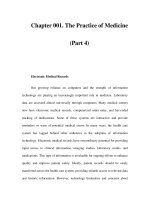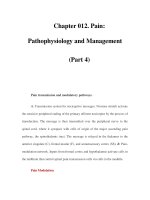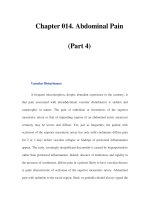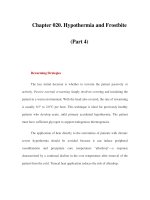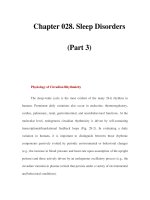Chapter 100. Megaloblastic Anemias (Part 4) pot
Bạn đang xem bản rút gọn của tài liệu. Xem và tải ngay bản đầy đủ của tài liệu tại đây (13.18 KB, 5 trang )
Chapter 100. Megaloblastic
Anemias
(Part 4)
Biochemical Basis of Megaloblastic Anemia
The common feature of all megaloblastic anemias is a defect in DNA
synthesis that affects rapidly dividing cells in the bone marrow. All conditions that
give rise to megaloblastic changes share in common a disparity in the rate of
synthesis or availability of the four immediate precursors of DNA: the
deoxyribonucleoside triphosphates (dNTPs): dA(adenine)TP and dG(guanine)TP
(purines), dT(thymine)TP and dC(cytosine)TP (pyrimidines). In deficiencies of
either folate or cobalamin, there is failure to convert deoxyuridine monophosphate
(dUMP) to deoxythymidine monophosphate (dTMP), the precursor of dTTP (Fig.
100-1). This is because folate is needed as the coenzyme 5,10-methylene-THF
polyglutamate for conversion of dUMP to dTMP; the availability of 5,10-
methylene-THF is reduced in either cobalamin or folate deficiency. An alternative
theory for megaloblastic anemia in cobalamin or folate deficiency is
misincorporation of uracil into DNA because of a build-up of deoxyuridine
triphosphate (dUTP) at the DNA replication fork as a consequence of the block in
conversion of dUMP to dTMP.
Cobalamin-Folate Relations
Folate is required for many reactions in mammalian tissues. Only two
reactions in the body are known to require cobalamin. Methylmalonyl CoA
isomerization, which requires adocobalamin, and the methylation of homocysteine
to methionine requires both methylcobalamin and both 5-MTHF (Fig. 100-1). This
reaction is the first step in the pathway by which 5-MTHF, which enters bone
marrow and other cells from plasma, is converted into all the intracellular folate
coenzymes. The coenzymes are all polyglutamated (the larger size aiding retention
in the cell), but the enzyme folate polyglutamate synthase can use only THF, not
MTHF, as substrate. In cobalamin deficiency, MTHF accumulates in plasma,
while intracellular folate concentrations fall due to failure of formation of THF,
the substrate on which folate polyglutamates are built. This has been termed THF
starvation, or the methylfolate trap.
This theory explains the abnormalities of folate metabolism that occur in
cobalamin deficiency [high serum folate, low cell folate, positive purine precursor
aminomidazole carboxamide ribonucleotide (AICAR) excretion; Table 100-2] and
also why the anemia of cobalamin deficiency will respond to folic acid in large
doses.
Clinical Features
Many symptomless patients are detected through the finding of a raised
mean corpuscular volume (MCV) on a routine blood count. The main clinical
features in more severe cases are those of anemia. Anorexia is usually marked and
there may be weight loss, diarrhea, or constipation. Glossitis, angular cheilosis, a
mild fever in the more severely anemic patients, jaundice (unconjugated), and
reversible melanin skin hyperpigmentation may also occur with deficiency of
either folate or cobalamin. Thrombocytopenia sometimes leads to bruising, and
this may be aggravated by vitamin C deficiency or alcohol in malnourished
patients. The anemia and low leukocyte count may predispose to infections,
particularly of the respiratory or urinary tracts. Cobalamin deficiency has also
been associated with impaired bactericidal function of phagocytes.
General Tissue Effects of Cobalamin and Folate Deficiencies
Epithelial Surfaces
After the marrow, the next most affected tissues are the epithelial cell
surfaces of the mouth, stomach, and small intestine and the respiratory, urinary,
and female genital tracts. The cells show macrocytosis, with increased numbers of
multinucleate and dying cells. The deficiencies may cause cervical smear
abnormalities.
Complications of Pregnancy
The gonads are also affected, and infertility is common in both men and
women with either deficiency. Maternal folate deficiency has been implicated as a
cause of prematurity, and both folate and cobalamin deficiency have been
implicated in recurrent fetal loss and neural tube defects, discussed below.
Neural Tube Defects
Folic acid supplements at the time of conception and in the first 12 weeks
of pregnancy reduce by ~70% the incidence of neural tube defects (NTDs)
(anencephaly, meningomyelocele, encephalocele, and spina bifida) in the fetus.
Most of this protective effect can be achieved by taking folic acid, 0.4 mg daily at
the time of conception.
The incidence of cleft palate and harelip can also be reduced by
prophylactic folic acid. There is no clear simple relationship between maternal
folate status and these fetal abnormalities, although overall the lower the maternal
folate, the greater the risk to the fetus. NTDs can also be caused by antifolate and
antiepileptic drugs.




